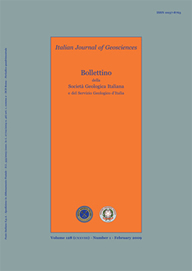
Neogene-Quaternary tectonics and sedimentation in the Central Apennines
Ernesto Centamore(*) & David Rossi(*)
(*) Dipartimento di Scienze della Terra, Università degli Studi di Roma «La Sapienza», P.le A. Moro, 5 - 00185 Roma. E-mail: ernesto.centamore@uniroma1.it; david.rossi@uniroma1.it
Volume: 128 (2009) f.1
Pages: 73-88
Abstract
The Central Apennines consist of a fold and thrust belt developed during the Neogene, involving sedimentary successions of different paleogeographic domains. The geodynamic evolution of this sector of the chain was controlled by several important tectonic events, highlighted by numerous depositional sequences recognized in the Neogene marine successions. Time-scanning of the stratigraphic events has allowed us to reconstruct: the different stages of the eastward shift of the chain-foredeep-foreland system; the deformation chronology; the recent effects of the interactions between the regional uplift and extensional tectonics in the chain and the progressive eastward tilting of the Periadriatic domain. During the Miocene-Early Pliocene interval the Tyrrhenian area constituted a remarkable topographic swell, linked to an upwelling mantle dome. As a consequence, intense erosional processes developed on this area, together with crustal delamination and lateral gravitational spreading. The Tyrrhenian-derived siliciclastic detritus fed the Apennine foredeep and thrust-top basins; the continuous asthenospheric uplift in the Tyrrhenian margin favoured the formation of axial crest grabens, crust delamination and the emplacement of a stack of gravitational nappes in the Apennine sector. The maximum uplift of the mantle doming was recorded at the beginning of the Upper Messinian. The remarkable uplift of several asthenospheric domes, located in the Mediterranean area, favoured the closing of the sea-ways, connecting the Atlantic with Peri-mediterranean basins. Consequently the salinity crisis developed, with a relative diachrony: the evaporites sedimented at first in the crestal areas and later in the deep ones. The marine episodes recognized in the lago-mare sediments represent the end of uplift processes and a progressive dome deflation with sporadic connections with the Atlantic. During the Middle Pliocene-Quaternary, the intense thinning of the Tyrrhenian crust induced the collapse of the axial dome and subsidence of the rift belt.
Keywords
Get Full Text